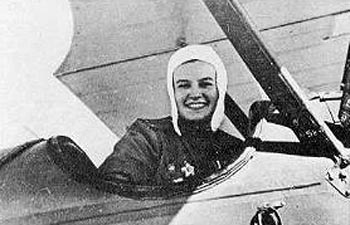They were all female, from the youngest teenage mechanic to the most combat-seasoned pilot. Natalya deployed with the regiment as a navigator; the second crew member who sat in the back of the plane to keep her pilot on course and to drop ordnance and flares as needed. Later on, Natalya became a pilot, and then a flight commander responsible for five crews and their planes.
The Night Witches are deeply revered heroes to the present day, and one of the most effective aircraft formations in World War II. 23 Night Witches, including Natalya, received the Soviet Union’s most prestigious war medal: Hero of the Soviet Union. The “girls’ flying regiment” caused so much fear and mayhem, the Nazis, out of sheer desperation, deployed their best night fighter squadron, equipped with their best planes, and gave them new instructions: destroy the Night Witches! Any Nazi pilot who succeeded in shooting down a Night Witch bomber was automatically awarded an Iron Cross.

described Natalya as the most beautiful navigator in the regiment.
The 588th flew the PO-2; a two-seater biplane that was so small it was nearly undetectable by radar, too slow for modern fighters to lock on to for more than a split second, and nearly silent. Worse still, WWII anti-aircraft crews were trained to fight large high-altitude bombers. When startled German gun crews and searchlight operators woke up to explosions, they would pour fire into the night, but with their weapons sighted far too high. It often took a long time for the bewildered enemy to realize all of the defensive fire was flying harmlessly past the girls’ tiny wood aircraft.
Between the summer of 1942 and the Third Reich’s unconditional surrender in May 1945, Natalya flew 840 combat missions. Some of these flights were harassment bombing runs – Natalya and her friends would fly as many sorties and drop as many bombs as humanly possible on German positions, especially headquarters units.
The PO-2s were simple biplanes with no proper bombsights, so these harassment attacks were inaccurate and rarely damaged anything, but that wasn’t the point. The constant barrage of bombs shell-shocked enemy troops and deprived them of sleep. In the morning, Soviet ground forces attacked Nazi invaders too exhausted to resist effectively.
Another purpose the Night Witches served was precision bombing against high-value targets. Even though the girl in the rear cockpit, who served as a navigator and bombardier, had nothing more than chalk lines on the wings to aim with, a PO-2 with a skilled crew flying as slow as 40-60km/hr. at low altitude could hit small targets with pin-point accuracy. In 1944, a squadron of Night Witches destroyed an entire fuel facility guarded by the Romanians. Enemy ground commanders were so humiliated by being defeated by a handful of girls in obsolete biplanes, they claimed the installation had been attacked by a hundred Soviet bombers!

In another unfortunate incident for the Nazis, a column of Axis troops and vehicles poured down a road at dawn’s early light. These terrified soldiers were in a frantic race against time to find a good hiding place before daylight. They crammed the road with vehicles, pack animals, and ground troops… just in time for a Night Witch plane to show up and spot a perfectly lined up target. The two women swooped in, leveled their wings, pulled the release cord, and blew their hated enemy into bloody chowder.
Not all Night Witch missions were about death and destruction. They often dropped propaganda leaflets. Later in the war, these tactics began to bear fruit. Beaten down, exhausted, hungry, and demoralized, Axis soldiers surrendered in droves. One time during the Endgame of the war, a soldier in the regiment found herself all alone, armed with only a rifle, standing guard over hundreds of prisoners – a situation that must have made her feel uncomfortable at the very least! Meanwhile, her friend scrambled to inform their command about what had just happened.

Their missions were often humanitarian. Naval infantry and other advance units in the Soviet army sometimes found themselves isolated and in urgent need of food, medical supplies, ammunition, and other necessities to continue fighting. There were also hundreds of thousands of partisans; men and women resisting the Nazi occupation, no cost or sacrifice too high to pay. The Night Witches were among the aviation units that assisted these fighters: they swooped down onto rough, tightly confined spaces – or sometimes just flew low enough to drop pods of supplies onto friendly positions.
Flying a PO-2 night bomber was no walk in the park. These sorties were all a dance with death. The planes were nimble and difficult to hit, but vulnerable. A single incendiary round into the carriage of the plane could set it ablaze like a tinder box, burning the young women inside alive. Out of an original complement of 40 aviators and the trickle of reinforcements behind them, 32 of these brave young patriots lost their lives in history’s single greatest struggle against evil.
In the first week of May, 1945, the war-weary Night Witches spun up their planes for yet another mission. They were exhausted, lonely from being separated from their families for so long, and grief-stricken by the continuing deaths of their friends. But then an urgent message arrived on the airfield; it was all over! The Nazis had surrendered! The aviators and their ground crews cheered, laughed, hugged, and cried. Their relief was overwhelming. The “1,100 Nights of War” were finally over!

The regiment decommissioned that October and, like most of her friends, Natalya left active service for a normal life. But she couldn’t quite resist her patriotic urges. In 1947, Natalya reenlisted to attend the Military Institute of Foreign Languages and served her country as a translator before retiring in 1957. Along the way she married and raised two children. Her younger child, a daughter, she named Marina; honoring Marina Raskova, the famed aviator who formed the women’s aviation corps that the 588th Night Bombers were a part of.
Natalya was a prolific writer and joined the prestigious Union of Soviet Writers in 1972. Above all else she memorialized the heroism of her friends during the “war years.” After a decades-long collaborative effort, the retired Night Witches ensured their story, and most importantly, the ultimate sacrifice of their beloved friends who went down in flames.

In 2005, the twilight of a long, interesting, and productive life, one might think it was time for Natalya to rest. But her job wasn’t quite over yet. Her girlfriends had written thousands of pages about their war experiences, many of those pages written or transcribed from interviews by Natalya herself, but there was one last step to be taken. Natalya joined forces with the former chief of staff of the regiment, Irina Rakabolskaya and wrote one last book; We Were Called Night Witches. This was the most detailed book about the regiment and brought the whole story together into a coherent narrative. Interestingly, this narrative was split in two. The first half of the book described the war from Irina’s perspective, the second half from Natalya’s. They finished their manuscript, but Natalya passed away that same year before it could be published. But she had accomplished her mission. The legend of the Night Witches is preserved, and available for anyone in future generations interested to learn about it.
Further reading about the Night Witches and other Soviet female aviators
Ian Kummer

Support my work by making a contribution through Boosty
All text in Reading Junkie posts are free to share or republish without permission, and I highly encourage my fellow bloggers to do so. Please be courteous and link back to the original.
I now have a new YouTube channel that I will use to upload videos from my travels around Russia. Expect new content there soon. Please give me a follow here.
Also feel free to connect with me on Quora (I sometimes share unique articles there).





